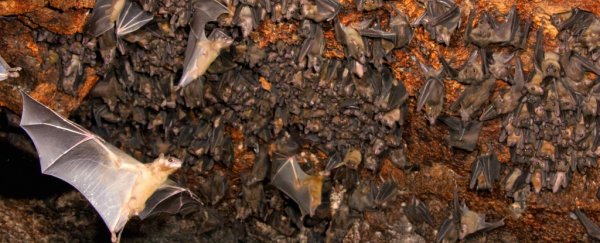A new study has shown that bats might have much more complexity to their speech than previously thought, including talking specifically to individuals in a group and getting into heated arguments - putting them on par with species such as dolphins.
The researchers, who were working with Egyptian fruit bats, listened into different bat calls and were able to tell what the bats were arguing about, who they were arguing with and even the disagreement's outcome.
"We have shown that a big bulk of bat vocalisations that previously were thought to all mean the same thing, something like 'get out of here!' actually contain a lot of information," lead researcher, Yossi Yovel, from the Tel Aviv University in Israel, explained to Nicola Davis at The Guardian.
Egyptian fruit bats, along with most other bats, are highly social creatures, roosting in trees or caves with up to 1,000 other individuals. But they are also very noisy creatures, and to humans, the sounds they make are pretty much indistinguishable from each other – and many all 'talking' at once can be deafening.
"Animals make sounds for a reason," Whitlow Au, from University of Hawaii, who wasn't involved in the research, told Ramin Skibba at Nature. "Most of the time, we don't quite understand those reasons."
To try and figure it out, the team spent 75 days recording continuous video and audio footage of 22 captive bats.
They modified voice-recognition software so they could analyse around 15,000 bat noises over the timeframe.
The program was able to link social interactions to the different noises, eventually classifying over 60 percent of the sounds into four contexts: food arguments, sleeping arrangement arguments, mating attempt arguments, and arguments when another bat got too close.
But the researchers also discovered that the bats would sometimes communicate directly with individuals, and they changed their tone depending on who they were talking to – especially between the sexes.
"Our finding might be akin to a human speaker who uses varying intonation towards different listeners (e.g. male vs. female addressees) while using the same words," the researchers wrote.
This puts Egyptian fruit bats into a special and very exclusive category of animals that address specific animals – the only other species we know of that do this include dolphins, some monkey species, and us.
But the researchers said that evolutionarily this makes sense – in dark caves where vision is secondary, speech could become more nuanced to convey the information usually done by vision.
"The importance of vocal communication increases when vision is limited (e.g. in dense forests or underwater), thus it is reasonable to assume that the vocalisations of a social mammal, which roosts in dark caves, will evolve to convey elaborate information about the interactions between individuals," the researchers added.
This kind of research is in its early stages, but the results so far have been impressive. While Yovel and his team are continuing their work to identify how the bats respond to different calls, the technique could be used for a number of different species.
"It could be that you could apply the same type of techniques to other species to figure out what they mean when they are interacting with each other," Kate Jones, from the University of London, who was not part of this study, said to The Guardian.
"So it could be that it opens up a different world of understanding what these communications are."
The research has been published in Scientific Reports.
